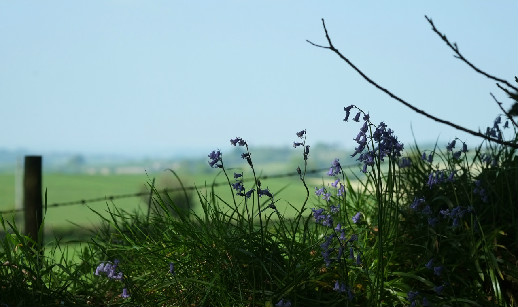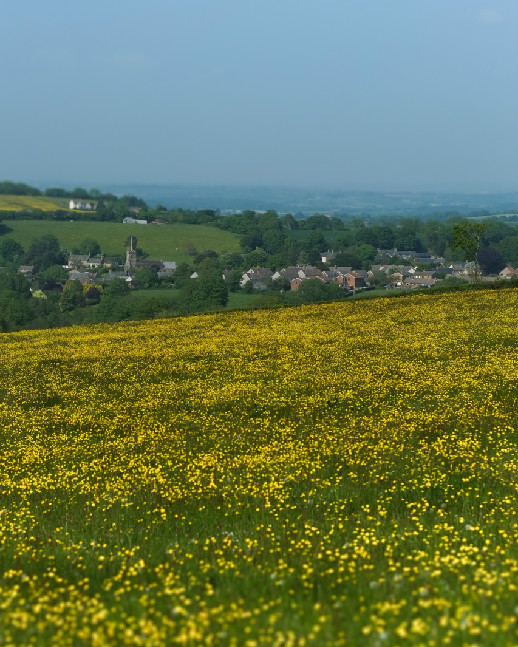Words and pictures by Malcom Anderson
Of all the places in the West Dorset of my youth, none crop up in memory as often as Pete’s Hill. A greensand island surrounded by an undulating sea of clay Pete’s Hill stands proud of the surrounding Dorset landscape, an earthy beacon hugged by a couple of lonely trees which are visible enough to have been used as a sight guide by returning world war two pilots. Its bare flanks are coated in long spear tipped grasses waving in the wind, anchored by the woody stems, vibrant yellow flowers and faint aroma of surfboard wax provided by the spiny gorse.
Seen from a distance the old farmhouse nestles in a higgledy-piggledy patchwork of small fields, tumbledown copses and crooked hedgerows. It’s not a toy farm in any way and has avoided becoming a pretty plaything for Ptolemy from Pimlico or Nigella from Northcote Road. Its buildings stand as resolutely ramshackle today as they did when Pete and I played around them, free of the worries of the world, during the 1980’s. The yard is still cluttered with magical ancient machinery, dinosaurs of an age when the Massey 135 was king. Iron carapaces slowly decomposing, releasing oxidized brittle flakes of ferrous blood to the rough concrete floor.
From the front door of the house Dorset falls away in front of you, an apple coloured sea of grass beech and oak, down to the valley floor then slowly rises up again towards the horizon in a giant earthy wave, cresting upon the rabbit cropped grasses of Iron Age earthworks.
Behind the farmhouse, across the rust flaked yard with its Massey-o-sauruses and Ford-o-dactyls is a nondescript agricultural silage and haybarn. Despite the best efforts of school educational films about the dangers of playing on farms, the signs on the sides of the barn may as well have said ‘here lies adventure’ to our young minds. During the summer months however the barn meant one thing. Work. Bales needed to be thrown up into the barn from tired flat bed trailers liberated once a year from their field-based slumber; ancient iron platforms with bald tyres, their beds coated in years of grass and flower seeds; smelling of sunshine, sneezes and axle grease. Over endless summer days the barn would fill as the hay came in from the fields ultimately being crammed right up to the asbestos ceiling and the murky opaque roof lights; pale squares of harvest moon coloured light in the dust filled darkness, their cobwebbed surface choked with the immobile husks of yesterday’s bluebottles.
Once the barn was filled to the brim with its meadow scented Lego blocks it was absolutely fair game for play and idle hands make dens in hay barns apparently. Our creative young minds, coupled with a lack of fear and common sense, had us creating vast tunnel networks through the bale stacks by pushing and pulling bales out of the way to create space. One year we got slightly carried away and created a cavern, its roof supported by sections of a ladder purloined from the yard. The only trouble was that Pete’s dad didn’t know about the ladder-supported area and whilst potentially looking for his misplaced ladder fell through the roof of our hidden den. I can vividly remember Pete’s rueful grimace as he recounted the tale of our dens discovery at school the next day in Beaminster.
Pete’s dad was a short, wiry man. Part of the Dorset landscape he lived in as much as the hedges and fields that were in turn shaped by his calloused hands. Baler twine the colour of panda pop the common thread between the man and the oak, beech and hazel that made up the hedges that line the base of the hill.
Climbing through the hedge line, just across from the front door of the farmhouse led to a marshy spring line, a blanket of soft rushes, squelchy footprints and flagstaff irises with their cheery flowers. At one point there was a tree stump in this corner of the field, the remains of a mighty beech. Try as they might, no Massey or Ford was ever able to drag this stump from it’s earthly embrace. No amount of pulling or cursing made a difference, the damn thing just wouldn’t budge. Turns out however that all it took was one hairy-footed Shire. A long steady pull, all steaming flanks and foaming mouth, and the roan powerhouse proved its superiority over man made machines. With a soggy tearing noise the roots were dragged out of the Dorset soil in the name of an imagined agricultural improvement which never came, the stumps removal exposing the spring line and accidentally creating a perfect wetland habitat forever more.
Heading uphill from the marshy hollow we pass alongside a copse of spindly pine plantation, half dead, home to nothing but rooks and shifting claw shaped shadows. Leaving the rooks behind, left to enjoy their own raucous house party, we come to the solitary majesty of the most perfectly shaped beech tree I have ever seen. Its trunk is so immutable and permanent that it seems as if a living fossil anchored to the earth, it’s crown a perfect copper umbrella.
Above the faraway tree with its burnished thatch we push on through long grass and bunches of gorse, up onto the summit of the hill. The four feet high concrete well cover on the very top of the hill, protects the farms water source, and also provides the perfect seat from which to admire the view. Turning 360 degrees it’s possible to see the transmitter masts at Penn Hill on the Mendips and Stockland Hill down near Honiton. On a summers day you can see, off to the south, the English Channel glimmering like gems spread on a blue carpet and as you fall off the back northwards there is a short but sweet section of long forgotten sunken lane which marks the boundary of the farm.
The open top of Pete’s hill made November 5th a true joy. From the comfort of the well cover it was possible to watch the firework displays in Drimpton, Broadwindsor, Crewkerne and in many other of the small hamlets and villages dotted throughout the darkening folds of the evening landscape, their house windows and the occasional streetlights twinkling like earth bound stars.
Not to be outdone by small towns and narrow minds for many years we had our own gunpowder, treason and plot parties up on top of the hill. There wasn’t much treason, unless you count some teenage lust-led decision making, and precious little plotting or planning; they were generally just an excuse for cider and legal incendiary devices.
As it turns out the safety adverts warning about the dangers of fireworks were right. One year, well into our teens and possibly when we should have known better, a Catherine wheel, attached to an upright railway sleeper by means of a slightly bent six inch nail hammered in beautifully with a handy flint node somehow worked its way loose. This fiery Frisbee, once free of its shackles, described a perfect soaring arc across the night sky and flew over our heads where it landed slap-bang in the middle of the large tin containing all of the other fireworks. A split second of holy-crap-silence, a brief pause where I couldn’t decide whether to run or to hold up a scorecard for the perfect acrobatics we had just witnessed, then the world exploded around us. Rockets shot between our legs, Catherine wheels looped over our heads and as one, we ran. We ran through nettle and gorse. We ran into a darkness so profound after the light of the fiery conflagration that nothing existed outside of a six foot radius, only the deeper shapes of prickly edged shadows that loomed up out of the inky night.
Despite the odd misadventure, the hill remains as close to being ‘home’ as any outdoor space can ever be. To Pete the hill was of course in every sense of the word, his. To the rest of us it was ours by proxy and standing on the concrete well cover looking out across the known world that meant that in effect, the world was ours too.


